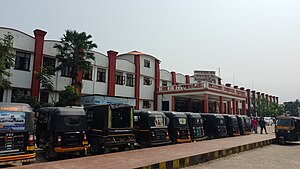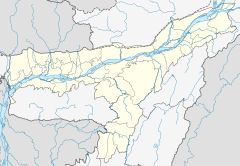| Badarpur Junction | |||||||
|---|---|---|---|---|---|---|---|
 Front view of Badarpur Junction Front view of Badarpur Junction | |||||||
| General information | |||||||
| Location | Badarpur, Assam India | ||||||
| Coordinates | 24°51′56″N 92°33′24″E / 24.8656°N 92.5567°E / 24.8656; 92.5567 | ||||||
| Owned by | Indian Railways | ||||||
| Operated by | Northeast Frontier Railway | ||||||
| Line(s) | Lumding–Sabroom section | ||||||
| Tracks | 9 (3 for passenger train) | ||||||
| Connections | |||||||
| Construction | |||||||
| Structure type | Standard | ||||||
| Parking | |||||||
| Bicycle facilities | |||||||
| Other information | |||||||
| Status | Functioning | ||||||
| Station code | BPB | ||||||
| Zone(s) | Northeast Frontier Railway | ||||||
| Division(s) | Lumding | ||||||
| History | |||||||
| Opened | 1898; 127 years ago (1898) | ||||||
| Closed | 2014 | ||||||
| Rebuilt | 2015 | ||||||
| Electrified | |||||||
| Services | |||||||
|
| |||||||
| |||||||
Badarpur Railway Station serves the Indian city of Badarpur in Assam. It belongs to Lumding railway division of Northeast Frontier Railway of India. It is located at Cachar district in the state of Assam. It is one of the oldest station of India built in 1898. The Station connects Badarpur to other regions of Barak Valley as well as many parts of India. Badarpur railway station is also the largest and most important railway station in Barak valley and south Assam region.
History
Assam Bengal Railway was incorporated in 1892 to serve British-owned tea plantations in Assam. The railway line from Chittagong to Badarpur was opened to traffic in 1898. In 1942 the management of Assam Bengal Railway was transferred to the Govt of India. It was amalgamated with the state managed Eastern Bengal Railway and designated as Assam Bengal Railway .
On 1 January 1942 the Assam Bengal Railway combined with the Eastern Bengal Railway to form the Bengal and Assam Railway. At time of the independence of India in 1947, Bengal–Assam Railway was split up and the portion of the system, about 2,603.92 km long which fell within the boundary of erstwhile East Pakistan was named as Eastern Bengal Railway, the control remaining with the central Government of Pakistan. Later, with the effect from 1 February 1961, Eastern Bengal Railway was renamed as Pakistan Railway.at the year 1958 Northeast Frontier Railways created and Badarpur Junction came under it.
Successors
With the partition of India in 1947, portions of the Assam Bengal Railway which lay in Assam and the Indian part of North Bengal became Assam Railway. North Eastern Railway was formed in 1952 by amalgamating Assam Railway with Oudh Tirhut Railway and Fatehgarh district of Bombay, Baroda and Central India Railway. Northeast Frontier Railway was carved out of North Eastern Railway in 1958.
The portion of the system which fell within the boundary of erstwhile East Pakistan was named as Eastern Bengal Railway. On 1 February 1961, Eastern Bengal Railway was renamed as Pakistan Railway and in 1962 it became Pakistan Eastern Railway . With the emergence of Bangladesh, it became Bangladesh Railway.
After the independence of Pakistan on 15 August 1947 the broad-gauge portion of the Assam Bengal Railway, lying in India was added to the East Indian Railway and the metre-gauge portion became the Assam Railway, with its headquarters at Pandu. On 14 April 1952, the 2857 km-long Assam Railway and the Oudh and Tirhut Railway were amalgamated to form one of the six newly carved zones of the Indian Railways: the North Eastern Railway zone. On the same day, the reorganised Sealdah division of the erstwhile Bengal Assam Railway (which was added to the East Indian Railway earlier) was amalgamated with the Eastern Railway.
Major trains
- Agartala - Anand Vihar Terminal Tejas Rajdhani Express
- Sir M. Visvesvaraya Terminal - Agartala Humsafar Express
- Lokmanya Tilak Terminus–Agartala AC Express
- Silchar–New Delhi Poorvottar Sampark Kranti Superfast Express
- Silchar - Thiruvananthapuram Aronai Superfast Express
- Silchar - Coimbatore Superfast Express
- Silchar–Secunderabad Express
- Rangiya–Silchar Express
- Guwahati–Dullabcherra Express
- Sealdah–Silchar Kanchanjunga Express
- Sealdah–Agartala Kanchanjunga Express
- Agartala - Firozpur Cantonment Tripura Sundari Express
- Silchar - New Tinsukia Barak Brahmaputra Express
- Deoghar–Agartala Weekly Express
References
- ^ R. P. Saxena. "Indian Railway History timeline". Archived from the original on 14 July 2012. Retrieved 24 February 2012.
- S. N. Singh; Amarendra Narain; Purnendu Kumar (January 2006). Socio Economic and Political Problems of Tea Garden Workers: A Study of Assam, Published 2006, ISBN 81-8324-098-4. New Delhi: Mittal Publications. ISBN 9788183240987. Retrieved 16 December 2011.
{{cite book}}:|work=ignored (help) - ^ "History". Bangladesh Railway. Archived from the original on 15 November 2007. Retrieved 11 January 2007.
- Rao, M.A. (1988). Indian Railways, New Delhi: National Book Trust, p.37
- "History". Northeast Frontier Railway. Archived from the original on 2 May 2014. Retrieved 24 February 2012.
- "History". Bangladesh Railways. Archived from the original on 15 November 2007. Retrieved 24 February 2012.
- Fida, Quazi Abul (2012). "Railway". In Islam, Sirajul; Jamal, Ahmed A. (eds.). Banglapedia: National Encyclopedia of Bangladesh (Second ed.). Asiatic Society of Bangladesh.
- Rao, M. A. (1988). Indian Railways, New Delhi: National Book Trust, p.39
- "Chapter 1 – Evolution of Indian Railways-Historical Background". Ministry of Railways, India website. Archived from the original on 1 June 2009.
- Rao, M. A. (1988). Indian Railways, New Delhi: National Book Trust, pp.42-3
- "Sealdah division-Engineering details". The Eastern Railway, Sealdah division. Archived from the original on 15 February 2012.
- "SMVT Bangalore-Agartala Humsafar Express". indiarailinfo.com.
- "Tiruvananthapuram-Silchar Aronai Express". indiarailinfo.com.
- "Silchar-Coimbatore Express". confirmtkt.com.
| Railway stations in Assam | |||||||||
|---|---|---|---|---|---|---|---|---|---|
| NEFRTooltip Northeast Frontier Railway zone |
| ||||||||

